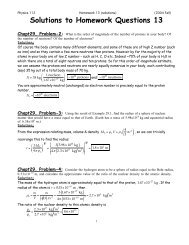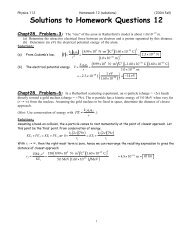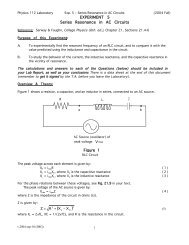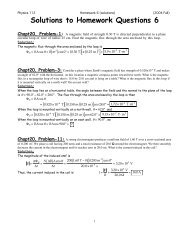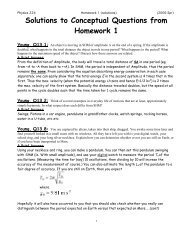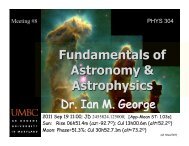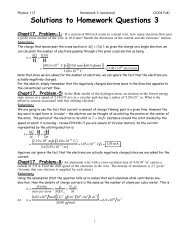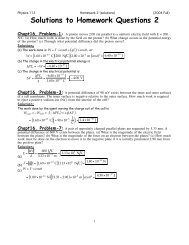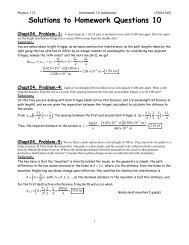Solutions to Homework Questions 1
Solutions to Homework Questions 1
Solutions to Homework Questions 1
You also want an ePaper? Increase the reach of your titles
YUMPU automatically turns print PDFs into web optimized ePapers that Google loves.
Physics 112 <strong>Homework</strong> 1 (solutions) (2004 Fall)<br />
Chapt15, Problem-7: Suppose that 1.00 g of hydrogen is separated in<strong>to</strong> electrons and pro<strong>to</strong>ns.<br />
Suppose also that the pro<strong>to</strong>ns are placed at Earth’s North Pole and the electrons are placed at the South<br />
Pole. What is the resulting compressional force on Earth?<br />
Solution:<br />
1.00 g of hydrogen contains Avogadro’s number of a<strong>to</strong>ms, each containing one pro<strong>to</strong>n and one electron. Thus,<br />
each charge has magnitude q = N A e . The distance separating these charges is r = 2 R E , where R E is the<br />
Earth’s radius. Thus applying Coulomb’s Law,<br />
F = k e( N A e ) 2<br />
( 2 R E ) 2<br />
⎛<br />
= 8.99 × 10 9 N ⋅m2 ⎞ ( 6.02 ×10 23<br />
) 1.60 × 10 −19 C<br />
⎜<br />
⎝<br />
C 2 ⎟<br />
⎠ 4 6.38 × 10 6 m<br />
[ ( )] 2<br />
( ) 2 = 5.12 ×105 N<br />
Chapt15, Problem-8: An electron is released a short distance above Earth’s surface. A second<br />
electron directly below it exerts an electrostatic force on the first electron just great enough <strong>to</strong> cancel the<br />
gravitational force on it. How far below the first electron is the second?<br />
Solution:<br />
The magnitude of the repulsive force between electrons must equal the weight of an electron, Thus by<br />
using Coulomb;’s Law and New<strong>to</strong>n’s 2 nd Law (applied <strong>to</strong> gravity), we have<br />
k e e 2 r 2 = m e g<br />
so rearranging this expression, and then making the substitutions, we get<br />
r =<br />
( )( 1.60 ×10 −19 C ) 2<br />
( )( 9.80 m s 2<br />
)<br />
k e e2<br />
m e<br />
g = 8.99 ×10 9 N⋅ m 2 C 2<br />
9.11 ×10 −31 kg<br />
Chapt15, Problem-11: Three charges are arranged<br />
as shown in Figure P15.11. Find the magnitude and direction<br />
of the electrostatic force on the charge at the origin.<br />
Solution:<br />
In the sketch <strong>to</strong> the right, F R is the resultant of the<br />
forces F 6 and F 3 that are exerted on the charge at<br />
the € origin by the 6.00 € nC and the –3.00 nC charges<br />
respectively. Applying Coulomb’s Law <strong>to</strong> each, we get<br />
⎛<br />
F 6<br />
= 8.99 ×10 9 N⋅ m 2 ⎞ 6.00 ×10 −9 C<br />
⎜<br />
⎝<br />
C 2 ⎟<br />
⎠ 0.300 m<br />
= 3.00× 10 −6 N<br />
⎛<br />
F 3 = 8.99 ×10 9 N⋅ m 2 ⎞<br />
⎜<br />
⎝<br />
C 2 ⎟<br />
⎠<br />
( )( 5.00 ×10 −9 C )<br />
( ) 2<br />
( 3.00× 10 −9 C) 5.00 × 10 −9 C<br />
( )<br />
0.100 m<br />
From the Superposition Principle, the resultant is<br />
F R = ( F 6 ) 2 ⎛<br />
+ F 3<br />
⎜<br />
⎝<br />
( ) 2 = 1.38 ×10 −5 N at θ = tan −1 F 3<br />
or F R = 1.38 ×10 −5 N at 77.5° below − x axis<br />
= 5.08 m<br />
( ) 2 = 1.35× 10 −5 N<br />
F 6<br />
⎞<br />
⎟ = 77.5° ,<br />
⎠<br />
2







